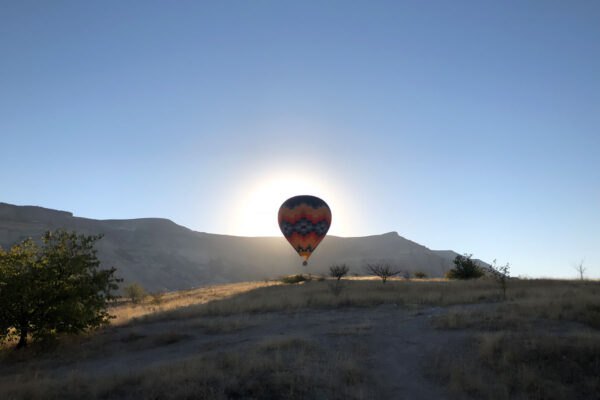Fear of heights may seem like an insurmountable barrier. However, ballooning offers a unique opportunity to gradually become accustomed to the airspace. Rising above the ground in a balloon gondola is an experience that combines adrenaline with calm. A quiet, gentle journey through the skies allows the body to naturally acclimate to the height.
Many people avoid balloon flights because of a fear of heights. Yet this mode of travel can become an effective method of therapy. The gentle ascent, stability of the balloon basket, and open nature of the gondola create sensations different from those experienced in enclosed spaces. The experience of balloon flight can reshape previous beliefs about heights.
What is fear of heights and why does it affect so many people
Fear of heights, known as acrophobia, affects millions of people worldwide. Statistics show that about 3-5% of the population experiences a clinical form of this phobia. However, a much larger percentage of people feel discomfort or anxiety in high places.
The mechanism of acrophobia
Acrophobia develops as a defense mechanism of the body. The brain interprets height as a potential threat to safety. The nervous system triggers defensive reactions against perceived danger. Adrenaline rises, the heart beats faster, and breathing becomes shallow.
Evolutionarily, fear of heights protected our ancestors from dangerous situations. Today, this natural reaction can be exaggerated and limit daily functioning. Modern safe environments are still interpreted by primitive brain mechanisms.
Genetic predispositions may influence susceptibility to developing a fear of heights. Traumatic childhood experiences often reinforce this fear. Some individuals develop acrophobia without any specific traumatic cause.
Physical and psychological symptoms
Main symptoms of acrophobia:
- Dizziness when looking down
- Accelerated heartbeat at heights
- Sweaty palms in high places
- Nausea when staying in elevated locations
- Chills and body trembling
- Panic feelings at the thought of height
The intensity of symptoms can vary greatly between individuals. Some experience mild discomfort; others have severe panic attacks. Symptoms may worsen depending on the specific height-related situation.
The psychological aspects of the phobia often prove harder to control than the physical ones. Negative thoughts and images intensify fear of heights. Avoiding high places can lead to worsening phobia.
The physiology of fear while rising above the ground
The body responds to height through complex physiological mechanisms. The nervous system activates the fight-or-flight response. Stress hormones affect the functioning of the entire body during exposure to high spaces.
Nervous system reactions
The autonomic nervous system controls unconscious reactions to fear. The sympathetic nervous system activates immediately upon detecting danger. The body prepares to defend itself or flee from perceived threats.
The parasympathetic nervous system is responsible for calming the body after stress. The balance between these systems determines the intensity of the reaction to height. Proper functioning of both systems is crucial for adaptation.
The influence of hormones on the perception of fear
Adrenaline is released instantly in response to stressful situations. Cortisol prolongs the body’s state of readiness for potential threats. Noradrenaline affects concentration and readiness to act.
Main hormonal changes during anxiety:
- Increase in adrenaline levels in the body
- Increase in cortisol in the bloodstream
- Release of noradrenaline in the brain
- Decrease in serotonin levels responsible for calmness
- Reduction of dopamine affecting mood
Prolonged altitude stress can lead to adrenal exhaustion. Chronic tension negatively impacts the immune system. Regular management of altitude-related stress is important for health.
Body adaptation to airspace
Gradual familiarization with height allows natural adaptation of the body. Repeated, safe altitude experiences reduce the intensity of stress reactions. The brain learns to interpret height as a safe space.
Tip: Starting by observing height through a window from a higher floor can be the first step in adaptation. Gradually increasing time spent in safe altitude spaces builds the body’s trust.
Breathing techniques effective in a balloon basket
Breath control forms the basis for mastering fear of heights during balloon flight. Conscious breathing techniques directly affect the nervous system. Proper lung ventilation provides oxygen needed to maintain calm.
Diaphragmatic breathing as a foundation
Abdominal breathing engages the diaphragm in lung ventilation. Deeper breathing supplies more oxygen to the brain and muscles. Conscious control of the diaphragm reduces tension throughout the body.
Placing one hand on the chest and the other on the abdomen helps control diaphragm movement. During inhalation, the abdomen should rise more than the chest. Exhalation should be longer than inhalation for maximum relaxation.
Regular practice of diaphragmatic breathing builds a habit of calm breathing in stressful situations. This technique can be used before and during balloon flight.
The 4-7-8 method in practice
The 4-7-8 technique involves timing each phase of breathing. Inhale lasts 4 seconds, hold breath for 7 seconds, exhale for 8 seconds. This rhythm naturally calms the nervous system.
Coordinating breath with balloon movements
Adjusting breathing to flight phases:
- Calm diaphragmatic breathing during balloon preparation
- Deep inhales during slow ascent
- Rhythmic breathing during stable flight
- Controlled exhales during gentle descent
- Relaxing breath after safe landing
Synchronizing breath with balloon movements helps build trust in the flying process. Conscious breathing during different flight phases reduces tension and fear.
Tip: Focusing on counting breath cycles during the flight helps divert attention from fear of heights. Counting breaths from 1 to 10 and then back to 1 creates a meditative rhythm that calms the mind.
Mental Preparation Before Your First Flight
Proper mental preparation determines the quality of your experience during a balloon flight. Building positive associations with flying begins long before the actual journey. Mental preparation allows you to transform fear into excitement.
Visualization of Positive Scenarios
Regularly imagining a successful balloon flight strengthens positive neural pathways in the brain. Detailed visualization of each phase of the trip builds trust in the process. The mind becomes accustomed to the idea of flying as a safe activity.
Imagining beautiful views from above replaces negative images associated with heights. Mentally rehearsing responses to various situations during the flight builds a sense of control.
Education About Balloon Flight Safety
Gaining knowledge about the construction and operation of balloons reduces uncertainty related to the unknown. Balloon flight safety statistics show that it is one of the safest forms of air transportation. Understanding how a balloon works provides rational grounds for trust.
Key Balloon Safety Information:
- Balloons use hot air to lift off
- Pilots undergo rigorous training and examinations
- Equipment undergoes regular technical inspections
- Flights take place only in favorable weather conditions
- The balloon basket is a stable structure ensuring safety
- Emergency landing is possible at any time
Familiarity with safety procedures and emergency protocols increases your sense of control during the flight. Information about pilot experience builds trust in professional service.
Relaxation Techniques Before Takeoff
Meditation and mindfulness techniques help achieve a calm state before the flight. Progressive muscle relaxation reduces muscle tension before the journey. Positive affirmations strengthen confidence and readiness for a new experience.
Listening to calming music or nature sounds can prepare the mind for a relaxing trip. Light physical activity before the flight helps release tension and stress.
Tip: Writing down your fears and replacing them with positive statements helps work through anxieties. Reading reviews and accounts from others who have overcome fear of heights during balloon flights provides inspiration and motivation.
Professional Balloon Flights with ProBallooning
ProBallooning stands out in the Polish ballooning market by combining professionalism with a passion for flying. The company offers hot air balloon flights in intimate groups, ensuring each passenger a window seat and personalized attention. The maximum number of passengers in the basket is 8 people, guaranteeing comfortable and safe flight conditions.
Experience and qualifications of the team
The founder of ProBallooning, Przemek Moscicki, is a pilot with over eight years of experience in ballooning. He has completed around 500 flights, gaining extensive experience in various weather conditions. His career began with sport flying, which is a typical path for most professional pilots.
Przemek Moscicki is a current member of the Polish National Team in gas balloon flights and a member of the Leszno Balloon Club. He regularly participates in competitions at the level of the Polish Cup and World Championships, demonstrating the highest level of piloting skills.
Specialized services and safety
Flights offered by ProBallooning:
- Scenic flights over the picturesque surroundings of Warsaw, Radom, and Lodz
- Private flights with the option to choose an individual route
- Romantic engagement and anniversary flights
- Family balloon adventures for groups up to 5 people
- Corporate and team-building group flights
Each ProBallooning balloon holds EU certificates and undergoes maintenance compliant with regulations. Flights are conducted only under favorable weather conditions, eliminating risks associated with unstable weather. The company provides transportation before and after the flight, facilitating the entire trip organization.
Customer reviews and feedback
ProBallooning enjoys an outstanding reputation among passengers, achieving an average rating of 5.0 based on positive Google reviews. Customers particularly emphasize professional flight organization, friendly atmosphere, and personalized approach to each participant.
Passengers often express surprise that the balloon flight turned out to be much calmer and safer than they expected. Many clients highlight that the experience exceeded their expectations and helped them overcome their fear of heights.
Before the first flight, you can contact the ProBallooning team to discuss concerns related to fear of heights. Experienced pilots often provide additional tips and support for people with acrophobia.
Gradual Acclimatization to the View from Heights
The process of adapting to high spaces requires a systematic and patient approach. Gradually increasing exposure to height allows the body to naturally acclimate. Every step toward overcoming fear brings lasting results.
Hierarchy of Height Exposure
Therapists recommend starting with the least stressful height situations. Observing heights through an apartment window is a safe starting point. Gradually moving on to balconies, terraces, and bridges builds the body’s trust.
Visiting tall buildings with panoramic elevators can be the next stage of adaptation. Corridors with glass walls in shopping centers offer a controlled height environment. Observation platforms with safety railings allow for safe height experiences.
The Role of a Controlled Environment
The balloon basket offers a unique combination of open space with a sense of security. The stability of the gondola eliminates the feeling of uncertainty typical of other forms of height exposure. Slow, gentle movements of the balloon allow for gradual acclimatization.
Advantages of the Balloon Basket for People with Fear of Heights:
- Solid, stable construction providing a sense of security
- Open space eliminating feelings of claustrophobia
- The option to sit or kneel in the basket
- Slow, predictable movements of the balloon
- The presence of an experienced pilot providing support
- A gradual lifting process allowing for adaptation
The presence of other passengers and a professional pilot creates an atmosphere of support and safety. The ability to communicate and receive instructions reduces feelings of isolation associated with fear.
Psychological Aspects of Adaptation
The brain adjusts to new experiences through neuroplasticity. Positive associations with heights can replace negative thought patterns. Every successful height experience strengthens feelings of competence and control.
Aware of their own progress, individuals are motivated to continue working on overcoming fear. Keeping a journal of height experiences helps track courage development. Celebrating small successes builds a positive attitude toward height challenges.
Tip: Taking photos of views from each new height creates a collection of positive memories associated with high spaces. Reviewing these photos reinforces positive associations and motivates further challenges.
Health and Emotional Benefits from Overcoming Phobia
Overcoming fear of heights brings significant benefits beyond just the flying experience. Conquering deeply rooted fears strengthens overall self-confidence and mental resilience. Success in confronting phobia opens doors to other life challenges.
Impact on the Nervous System and Stress
Systematic exposure to high-altitude situations trains the nervous system in stress management. The body learns to recognize false alarms and appropriately modulate defensive reactions. Improved emotional regulation carries over into other areas of life.
Reducing chronic stress related to avoiding heights positively impacts overall health. Lower cortisol levels improve immune system function. Better stress management benefits sleep and digestion.
Psychological Strengthening and Personal Development
Main psychological benefits of overcoming acrophobia:
- Increased sense of self-efficacy in difficult situations
- Improved self-esteem and confidence in one’s abilities
- Development of resilience to stress and new challenges
- Expansion of comfort zone and readiness for new experiences
- Greater motivation to take on further personal challenges
- Improved quality of life through elimination of phobic limitations
Success in overcoming a specific phobia often motivates work on other limitations. The experience of controlling one’s fear builds universal skills for coping with difficulties.
Social and Practical Benefits
Overcoming fear of heights opens access to many social and professional opportunities. Travel, high-altitude tourism, and recreational activities become available without phobic restrictions. Professional benefits may include new career opportunities in fields requiring work at heights.
Increased self-confidence positively affects interpersonal relationships and communication. People often perceive those who have overcome their fears as braver and more inspiring. Positive behavioral changes can enhance satisfaction with social life.
Tip: After a successful balloon flight, celebrate the achievement and share the experience with close ones. Talking about the success in overcoming fear of heights reinforces positive associations and motivates further personal growth.
Summary
Overcoming fear of heights during a balloon flight is an achievable goal through a systematic approach and appropriate techniques. Understanding the mechanisms of acrophobia, combined with practical stress management methods, creates a solid foundation for success. Breath control, mental preparation, and gradual exposure to height build the confidence needed for a safe flying experience.
Professional services from companies like ProBallooning provide a safe and supportive environment for first ballooning experiences. Experienced pilots, certified equipment, and small passenger groups create optimal conditions for overcoming fear of heights. The benefits of conquering height phobia extend far beyond the flight itself, strengthening overall mental resilience and opening new life opportunities.





